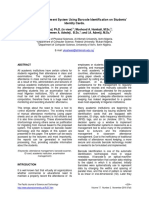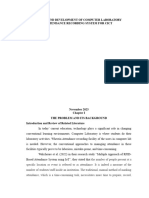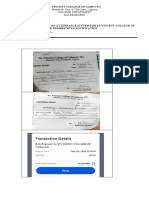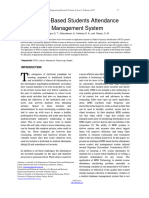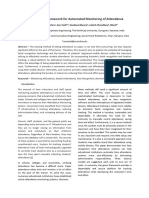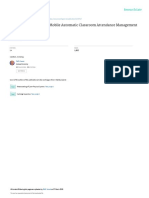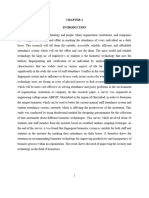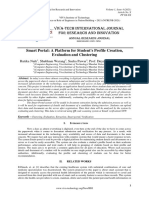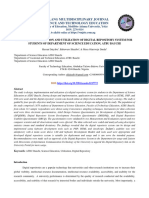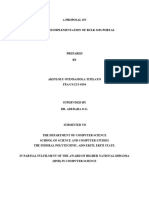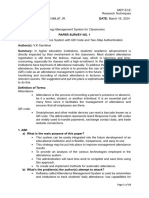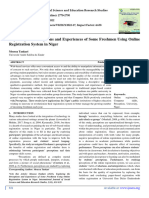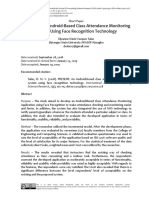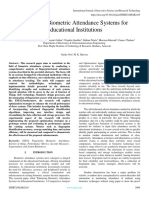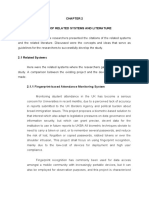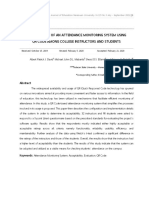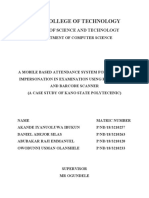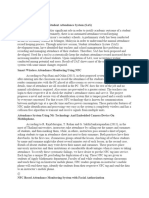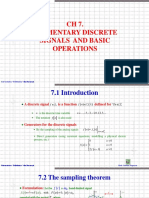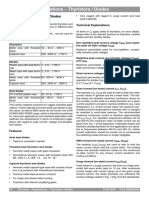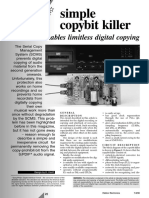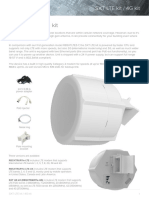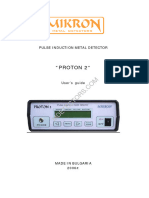Attendance Management System Using Barcode Identification On Students' Identity Cards
Attendance Management System Using Barcode Identification On Students' Identity Cards
Uploaded by
Irina PetreCopyright:
Available Formats
Attendance Management System Using Barcode Identification On Students' Identity Cards
Attendance Management System Using Barcode Identification On Students' Identity Cards
Uploaded by
Irina PetreOriginal Title
Copyright
Available Formats
Share this document
Did you find this document useful?
Is this content inappropriate?
Copyright:
Available Formats
Attendance Management System Using Barcode Identification On Students' Identity Cards
Attendance Management System Using Barcode Identification On Students' Identity Cards
Uploaded by
Irina PetreCopyright:
Available Formats
See discussions, stats, and author profiles for this publication at: https://www.researchgate.
net/publication/311511130
Attendance Management System Using Barcode Identification on Students'
Identity Cards
Article · December 2016
CITATIONS READS
9 32,142
4 authors, including:
Saheed Yakub Moshood A. Hambali
Al-Hikmah University,Ilorin, Nigeria Federal University Wukari
24 PUBLICATIONS 39 CITATIONS 21 PUBLICATIONS 79 CITATIONS
SEE PROFILE SEE PROFILE
Ismaeel Aderibigbe Adeniji
Al-Hikmah University
3 PUBLICATIONS 12 CITATIONS
SEE PROFILE
Some of the authors of this publication are also working on these related projects:
Microarray View project
Collaboration Research View project
All content following this page was uploaded by Moshood A. Hambali on 08 December 2016.
The user has requested enhancement of the downloaded file.
Attendance Management System Using Barcode Identification on Students’
Identity Cards.
Y.K. Saheed, Ph.D. (in view)*1; Moshood A. Hambali, M.Sc.2;
Abdulmumeen A. Adedeji, B.Sc.1; and I.A. Adeniji, M.Sc.3
1
Department of Physical Sciences, Al-Hikmah University, Ilorin-Nigeria.
2
Department of Computer Science, Federal University, Wukari-Nigeria.
3
Department of Computer Science, University of Ilorin, Ilorin-Nigeria.
*
E-mail: yksaheed@alhikmah.edu.ng
ABSTRACT employees or students for effective functioning,
planning, and management of the organization.
All academic institutions have certain criteria for In most academic institutions in developing
students regarding their attendance in class and countries, attendance is usually taken manually
examinations. The importance of student using paper sheets and the old file system
attendance in class cannot be over emphasized, approach by calling students name. According to
as a result of this, administrators and lecturers of (Tabassam, et al., 2009) it becomes
various academic institutions are concerned with cumbersome for the management to regularly
the attendance irregularities. In the process of update the records and manually calculate the
admitting students into an examination hall in percentage of classes attended for the purpose
most Nigerian institutions, 70% of attendance of examinations and subsequent results
must be met and also considered for grade processing. Lack of adequate attendance record
computation, therefore there is a huge need for keeping has indeed degenerated to a greater
monitoring and recording students’ attendance. level most especially in Nigerian institutions.
This brings about the need to have a tool to Many academic institutions are beginning to
control students’ attendance. The existing model update their standards by issuing students with
of manual attendance monitoring (using paper identification cards that are equipped with
sheets and an old file system) is not efficient and barcodes, ID chips, radio frequency identification
it is also time consuming. These aforementioned (RFID) tags, and so on (Andrew, 2011). This
shortcomings among others serve as justification decision opens up a window to implement
for migrating from manual based to the proposed barcode identification systems in classrooms as a
system. The system is based on barcode reader management tool to solve many of the problems
technology and the details of this system are faced by lecturers and the institutions’
presented in this paper. The system can be easily management in classroom attendance
accessed by the lecturers and most importantly, management. Due to the inefficiency of traditional
the reports can be generated in real-time methods of attendance record keeping, a more
processing, thus, providing valuable information secure and accurate barcode technology model
about the students. is needed to be formulated and implemented.
(Keywords: attendance management, barcode scanner, Barcode Identification is one of the automatic
ID card, academic institution, examination identification technologies more in vogue
management) nowadays. A barcode is an optical machine-
readable representation that contain data relating
to the object in which it is attached. Initially
INTRODUCTION barcodes were systematically use to represent
data by changing the widths and spacing of
It is well known fact that virtually all organizations parallel lines, and this kind of pattern is referred
whether commercial or educational need to to as linear or one-dimensional (1D). Later they
maintain a properly record the attendance of its
The Pacific Journal of Science and Technology –224–
http://www.akamaiuniversity.us/PJST.htm Volume 17. Number 2. November 2016 (Fall)
emerge into rectangles, dots, hexagons and other down their names on a piece of paper, or they
geometric patterns in two dimensions (2D). have to provide a list of enrolled students and
ask them to mark their names. This means that
Although 2D systems use difference variation of excessive manual efforts go into the process of
symbols, they are also referred to as barcodes as classroom attendance registrations. After the
well. Barcodes originally were recognized by data has been collected, it takes even more time
special optical scanners called barcode readers. and efforts to transfer the data onto other
Since their inception, barcodes were credited to systems for data analyses. One of the major
Joseph Woodland (Charles, 2001), the concept of flaws of the present system is the fact that,
barcodes have grown from the initial linear attendance registration information is not
barcodes “one dimensional” to the Matrix code properly used to help improve course timetables
“two dimensional” and this invention have been and classroom bookings. Another important
applied to many areas of life which include piece of information which the present system
supermarkets, pharmacies, warehouses, libraries, lacks is the time of individual attendance
and shopping centers. records. For example, a question of whether the
majority of students were present at the
beginning of a class or at later times could help
STATEMENT OF THE PROBLEM in improving classroom related research.
One of the most prominent areas where This application requires correct feed on input in
classroom practices of individual faculty members to the respective field. Suppose the wrong inputs
differ is on the issue of attendance policies. Some are entered, the application resist to work, so the
faculty members require attendance, some faculty user find it difficult to use.
count attendance positively in grade
determination, while others count the lack of
attendance against the student's grade. Even LITERATURE REVIEW
most faculty who don't require attendance by their
students, encourage attendance in a variety of There are numerous proposals for Automatic
ways. Fundamentally, most faculty members Attendance Management Systems in the
probably believe that attendance is significant in literature and in the market. Nowadays, barcodes
student success but most of us can provide only are frequently used in most industries,
anecdotal evidence to support our belief. supermarkets, and wherever information needs
to be read automatically.
The existing system is a manual entry for the
students. Here the attendance will be recorded in Shoewu, Olaniyi, and Lawson (2011) proposed
hand written registers. It usually is a tedious job an electronic card-based solution to the lecture
to maintain the records for the users. The attendance problem in higher institutions in the
retrieval of the information is not as easy as the developing countries. This system used a single-
records are maintained in the hand written chip computer based on subsystems interfaced
registers. serially to the serial port of the digital computer.
Some of the limitations of this system are that not
Registration systems are implemented in many all computer systems possess serial port.
institutions for various reasons. While the
purpose of these systems is not a focus in this Mahyidin (2008) also proposed student
paper, it is clear that statistical information is attendance management system using Radio
required by most of those institutions that have a Frequency Identification (RFID). The system
large number of students. makes use of student card in order to grant or
denial the student from taking attendance. This
Since collecting attendance data in many technique also did not identify individual based
institutions has not been computerized, the on who he/she is which therefore, can lead to
proposal of transforming the present system was impersonation.
alluring and decided to face the challenge and
design a solution for it. Victor, Jonathan, Reece, and Lemire (2003)
presented a system that is based on student wolf
In the present attendance registration system, pack club tracking system to improve the process
teachers have to either ask the students to write of student wolf pack club ticket distribution for
The Pacific Journal of Science and Technology –225–
http://www.akamaiuniversity.us/PJST.htm Volume 17. Number 2. November 2016 (Fall)
athletic events. This system did not, however, ID cards generally give lots of advantages to the
integrate any aspect of student attendance user. For this study, we explore the advantages
monitoring. of using ID cards to fill in class attendance. One
of the advantages is that ID card will make it
On the other hand, Saraswat and Kumar (2010), easier for students to fill in the class attendance.
proposed fingerprint verification technique in The time constraint of using ID card to fill in class
taking attendance. Their proposed system makes attendance is relatively small compared to the
use of fingerprint verification by using extraction of traditional attendance system which use paper
minutiae technique and system that automates sheet. Another improvement is the possibility to
the whole process of taking attendance. process the information directly on the card.
Xue (2009), discusses a prototype system that The barcode on the students' ID card must be
uses facial recognition technology to monitor and accurate in terms of width and darkness in order
authenticate user or student for attendance taking. to ensure the accurate data retrieved.
A neural network-based algorithm was
implemented to carry out face detection, and an For this work, students have to sign in
eigen face method was employed to perform electronically with ID card at the beginnings of
facial recognition. The experimental results each class. Each student has their own ID card to
demonstrate the feasibility of near-real-time fill in class attendance signing system. By using
continuous user verification for high-level security this system, students can discipline themselves
information systems. to always carry their student ID card as it is
compulsory for attendance marking.
METHODOLOGY The computer that implements this system is
equipped with a barcode reader. Students fill in
The barcodes would be attached at the back of their class attendance by swiping their card at the
each student’s ID card and the information that barcode reader which automatically records the
would be embedded in the barcodes will contain attendance information in the server. The reader,
unique data of the student such as matriculation in turn, communicates with card, thereby acting
number, department, faculty, year and all other as the intermediary before sending the data to
important information about the student. Students the server.
are able to participate in the class attendance only
by swiping their identity card through the barcode The barcode reader wiggles the barcode on the
reader. They can view their attendance ID card and record the data in the server. That
percentage which will motivate them to control way, data can be processed immediately and in a
their class attendance reputation. With real time totally automated way. At the end of the
clock capability of the system, attendance taken semester, lecturers can get the calculation of the
will be more accurate since the time for the students' attendance percentage more efficiently
attendance taken will be recorded. and view the standard attendance report.
Description of the Proposed System Advantages of the Proposed System
This study focused on reducing effort on paper The designed system is a fully automated
work and save the time required to generate system, reliable, fast, accurate, eliminate paper
accurate results from the student’s attendance. work, it saves times, eliminate attendance by
The proposed system of attendance management proxy, eliminate data forging, it also or serve as
is implemented using barcode technology. a tool to monitor student that skip class in order
Student’s record are entered into the system and to inform their parents, student don’t need to
tied to the barcode. The code is uniquely have multiple card.
associated to each student’s details for easy
identification.
The Pacific Journal of Science and Technology –226–
http://www.akamaiuniversity.us/PJST.htm Volume 17. Number 2. November 2016 (Fall)
SYSTEM MODEL DIAGRAM RESULTS AND DISCUSSION
Start
Login
Admin Student
Verify
Course Students Report
Barcode
Student Staff Attendan
s List ce
Record
Attendance
Data Update View
Entry Figure 2: Administrator Interface.
Report
Module Description
Report
The system should be designed in such a way
that only authorized people should be allowed to
access some particular modules. The records
should be modified by only administrators and no
one else. The user should always be in control of
Stop the application and not the vice versa.
The user interface should be consistent so that
Figure 1: Propose System Model. the user can handle the application with ease and
speed. The application should be visually,
conceptually clear.
Analysis of Processing Procedure
Attendance Management System basically has Administrator Module
two main modules for proper functioning:
Student Details: This module deals with the
1. Admin module is has rights for creating any allocation of roll no and personal details for new
new entry of faculty and student details. batch. It will generate personal details of student
and academic details of the students with the
2. User has a right of making daily attendance, passport photos.
generating report. Attendance report can be
taken by given details of student details such
as date, class etc.
The Pacific Journal of Science and Technology –227–
http://www.akamaiuniversity.us/PJST.htm Volume 17. Number 2. November 2016 (Fall)
System Database Home Page
Figure 3: Student Registration Interface. Figure 5: Home Page.
Staff Details: It helps to allot the subject and the
subject code to the particular staffs. It provides
the facility to have a user name and password to
the staffs.
Staff Registration Interface
Figure 4: Students’ Enrolment Interface.
Figure 6: Staff Enrolment Page.
The Pacific Journal of Science and Technology –228–
http://www.akamaiuniversity.us/PJST.htm Volume 17. Number 2. November 2016 (Fall)
Attendance Details: It will help to get the report Analysis of Output
of weekly and consolidate of the attendance.
Output design for this application “Student
Report Details: Report can be taken by daily, Attendance Management System” generally
weekly and consolidate. refers to the reports and information that are
generated by the system from many end-users;
Weekly reports get all hour details of attendance output is the main reason for developing the
starting date to ending date and displays the system and the basis on which they evaluate the
status. The consolidated report presents all usefulness of the application.
student attendance details starting date to ending
date. The output is designed in such a way that it is
attractive, convenient, and informative. Forms
are designed with various features, which make
Staffs Module the console output more pleasing. As the
outputs are the most important sources of
Attendance Details: It assists the staff to mark information to the users, better design should
attendance for their subject. This will authenticate improve the system’s relationships with user and
the staff before making the entry. also help in decision making. Form design
elaborates the way output is presented and the
layout available for capturing information.
Student Attendance Record
CONCLUSION
Computerizing classroom attendance tracking
has many advantages over the old system. Data
from classrooms can easily be transformed into
databases for possible later analyses or usages.
This may help in improving the design of
timetables and classroom reservation decisions.
A major disadvantage, however, is maintaining
the software program of the system. The goal of
this work was to test and evaluate a real-time,
system using barcode on students ID card. The
results from the tests that were conducted on the
system collectively show that the system design
is suitable for technological challenges that
require real-time solutions. Furthermore, the
success of these tests left no doubt that barcode
solutions are easy to implement, inexpensive in
terms of cost, and effective in terms of reliability
Figure 7: Student Attendance Record Page. and efficiency. A minor concern, however, might
be in the area of maintenance.
Report Details:
REFERENCES
1. Weekly report get particular hour details
of attendance from starting date to ending 1. Wright, A.W. 2011. “Radio Frequency
date and display the status. Identification Classroom Management System”. B.
Sc. project, California Polytechnic State
2. Consolidated report get all student University. http://digitalcommons.calpol.edu/imesp/70
attendance details from starting date to Retrieved on Dec. 20th, 2015.
ending date status help for the eligibility
criteria of the student to attend the 2. Application Notes. 2008. “Introduction to RFID
Technology”. CAENRFID: The Art of Identification.
examination.
The Pacific Journal of Science and Technology –229–
http://www.akamaiuniversity.us/PJST.htm Volume 17. Number 2. November 2016 (Fall)
3. Fisherman, C. 2001. “The Killer App - Bar None”. ABOUT THE AUTHORS
Retrieved 2010-04-19.
Y.K. Saheed, is a Lecturer at the Department of
4. Mahyidin, M. 2008. “Student Attendance Using Physical Sciences, Al-Hikmah University, Ilorin.
RFID System”. Thesis, Electrical and Electronics
Engineering Department, University of Malaysia,
He is currently working towards his Ph.D. degree
Pahang. Retrieved March 2nd, 2015 from in the Department of Computer Science, Kwara
http://umpir.ump.edu.my/345/1/3275Firdaus.pdf. State University, Malete, Kwara State, Nigeria.
He holds a Master of Science degree (M.Sc.) in
5. Kassim, M. H. Mazlan, N. Zaini, and M.K. Salleh. Computer Science from the University of Ilorin
2012. “Web Based Student Attendance System and B.Sc. degree from Al-Hikmah University,
Using RFID Technology”. 2012 IEEE Control and Ilorin, Nigeria. His research interests are
System Graduate Research Colloquium, no. Icsgrc, computer arithmetic with emphasis on residue
pp. 213–218. number systems architectures and applications,
6. Saraswat, C. and Kumar, A. 2010. “An Efficient
cryptography, and fault-tolerant computer
Automatic Attendance System Using Fingerprint arithmetic circuit designs. He is a member of
Verification Technique”. International Journal on IAENG.
Computer Science & Engineering. 2(2):264-269.
Moshood A. Hambali, is a Lecturer at the
7. Seideman, T. (n.d.). “Barcodes Sweep the World. Federal University Wukari. He is a graduate
Wonder of Modern Technology”. member of the IEEE and IEEE Computer Society
http://www.barcoding.com/information/barcode_history.shtml Member. He holds a Master of Science (M.Sc.) in
Computer Science from the University of Ilorin
8. Shoewu, O., O.M. Olaniyi, and A. Lawson. 2011.
“Embedded Computer-Based Lecture Attendance
and B.Sc. in Computer Science Al-Hikmah
Management System”. African Journal of University, Ilorin. His research interests are in
Computing & ICT. 4 (3): 27- 36. bioinformatic, data mining, and information
security.
9. Tabassam, N., P. Saim, K. Arash, and K. Azhar.
2009. “Development of Academic Attendance Abdulmumeen A. Adedeji, holds a B.Sc. degree
Monitoring System Using Fingerprint Identification. in Computer Science from Al-Hikmah University,
International Journal of Computer Science and Ilorin, Nigeria.
Network Security. 9(5):164-168.
10. Lim, T.S., S.C. Sim, and M.M. Mansor. 2009.
Ismaeel A. Adeniji, holds a Master of Science
“RFID Based Attendance System”.Oct.2009 IEEE (M.Sc.) in Computer Science from the University
Symposium on Industrial Electronics and of Ilorin and B.Sc. in Computer Science from Al-
Applications, No. Isiea.778–782. Hikmah University, Ilorin. His research interest
focuses in the areas of data mining and
11. Victor, S., M. Jonathan, J. Reece, and J. Lemire. Information security.
2003. “Student Wolf Pack Club Tracking System”.
North Carolina State University.
SUGGESTED CITATION
12. Xue Dong Yang. 2009. “A Facial Presence
Monitoring System for Information Security,
Computational Intelligence in Biometrics: Theory,
Saheed, Y.K., M.A Hambali, A.A. Adedeji, and
Algorithms, and Applications”. CIB 2009. IEEE I.A. Adeniji. 2016. “Attendance Management
Workshop on, March 30 2009-April 2 2009, 69 – System Using Barcode Identification on Students’
76. Identity Cards”. Pacific Journal of Science and
Technology. 17(2):224-230.
13. Zatin Singhal and Rajneesh Kumar Gujral. 2012.
“Anytime Anywhere- Remote Monitoring of
Attendance System Based on RFID using GSM Pacific Journal of Science and Technology
Network”. International Journal of Computer
Applications (0975 – 8887): 39 (3).
14. Yong, Z.Q. and L. Ji. 2006. “The Design of
Wireless Fingerprint Attendance System. 2006”.
International Conference on Communication
Technology. 1–4.
The Pacific Journal of Science and Technology –230–
http://www.akamaiuniversity.us/PJST.htm Volume 17. Number 2. November 2016 (Fall)
View publication stats
You might also like
- M6 Control Unit: Professional Manual Version 1.0Document22 pagesM6 Control Unit: Professional Manual Version 1.0Jhezy Andron Andron100% (2)
- Attendance Management System Using Barco PDFDocument7 pagesAttendance Management System Using Barco PDFJohnrich GarciaNo ratings yet
- BODYDocument45 pagesBODYbanogjonathan8No ratings yet
- BodyDocument28 pagesBodyMelina Jane DazoNo ratings yet
- Design and Development of Computer Laboratory Attendance Recording System For CictDocument14 pagesDesign and Development of Computer Laboratory Attendance Recording System For CictAllyzzah Celvhin MatiasNo ratings yet
- Fingerprint Based Student Attendance Management System With Automatic Excel ComputationDocument14 pagesFingerprint Based Student Attendance Management System With Automatic Excel ComputationTanveer RamzanNo ratings yet
- Fingerprint Based Student Attendance Management System With Automatic Excel ComputationDocument18 pagesFingerprint Based Student Attendance Management System With Automatic Excel ComputationTanveer RamzanNo ratings yet
- Development of Attendance Management System Using BiometricsDocument9 pagesDevelopment of Attendance Management System Using BiometricsAn IshNo ratings yet
- AtendmngDocument9 pagesAtendmngBenNo ratings yet
- Fingerprint Attendance System Chapter OneDocument7 pagesFingerprint Attendance System Chapter Oneotu deborahNo ratings yet
- Fingerprint Attendance System Chapter OneDocument7 pagesFingerprint Attendance System Chapter Oneotu deborahNo ratings yet
- Bawar ALiteratureReviewonSmartAttendanceSystemsDocument8 pagesBawar ALiteratureReviewonSmartAttendanceSystemsjohnjeffersonmamuad22No ratings yet
- S.E Defense Receipt and ActivityDocument9 pagesS.E Defense Receipt and ActivityMhie RecioNo ratings yet
- SJET 62 49 53 CDocument6 pagesSJET 62 49 53 Cjohnjeffersonmamuad22No ratings yet
- Dr. Arvind-K-Sharma PDFDocument7 pagesDr. Arvind-K-Sharma PDFICT Dept CUSNo ratings yet
- Baby ThesesDocument8 pagesBaby ThesesRizalyn TamanNo ratings yet
- An Android-Based Face Recognition SystemDocument6 pagesAn Android-Based Face Recognition SystemericjibrillaNo ratings yet
- SJET 62 49 53 CDocument6 pagesSJET 62 49 53 CRishabh ShuklaNo ratings yet
- Related Systems Foreign and LocalDocument16 pagesRelated Systems Foreign and Localkarijsd08No ratings yet
- RFID Students Attendance Management SystDocument9 pagesRFID Students Attendance Management Systnhatkhoa03xNo ratings yet
- Manuscript Anu+ (1) Final+PDF+Document10 pagesManuscript Anu+ (1) Final+PDF+random saneNo ratings yet
- 7 Smart Attendance and Leave Management System Using Fingerprint Recognition For Students and Employees in Academic Institute - 2Document10 pages7 Smart Attendance and Leave Management System Using Fingerprint Recognition For Students and Employees in Academic Institute - 2rodriguezlillian472No ratings yet
- Design and Development of Portable Classroom Attendance System Based On Arduino and Fingerprint BiometricDocument5 pagesDesign and Development of Portable Classroom Attendance System Based On Arduino and Fingerprint BiometricViru BadbeNo ratings yet
- Review of Related LiteratureDocument8 pagesReview of Related LiteratureAngelina Julia I. BautistaNo ratings yet
- Face Recognition-Based Mobile Automatic Classroom Attendance Management SystemDocument5 pagesFace Recognition-Based Mobile Automatic Classroom Attendance Management SystemGhamdanNo ratings yet
- Thesis Chapter 1Document8 pagesThesis Chapter 1William CortezNo ratings yet
- The Problem and Its BackgroundDocument21 pagesThe Problem and Its BackgroundAbigail AquinoNo ratings yet
- QR Code ThesisDocument24 pagesQR Code Thesismariel flores100% (1)
- Iot Based Instructor TrackingDocument59 pagesIot Based Instructor TrackingNari gaming Nari kootamNo ratings yet
- Face Recognition System For Automated Student AttendanceDocument3 pagesFace Recognition System For Automated Student AttendanceEditor IJTSRDNo ratings yet
- ASystematic Reviewof Deep Learning Based Online ExamDocument19 pagesASystematic Reviewof Deep Learning Based Online Examabourifa hananeNo ratings yet
- An Android-Based Face Recognition System For Class Attendance and Malpractice ControlDocument6 pagesAn Android-Based Face Recognition System For Class Attendance and Malpractice ControlRudra PremaNo ratings yet
- Attendance System Using A Mobile Device: Face Recognition, GPS or Both?Document8 pagesAttendance System Using A Mobile Device: Face Recognition, GPS or Both?gregorio eulinNo ratings yet
- Review of Related Literature of Attendance Monitoring SystemDocument5 pagesReview of Related Literature of Attendance Monitoring SystemafdtuwxrbNo ratings yet
- Smart Portal: A Platform For Student's Profile Creation, Evaluation and ClusteringDocument6 pagesSmart Portal: A Platform For Student's Profile Creation, Evaluation and ClusteringVIVA-TECH IJRINo ratings yet
- WSSM 2016Document7 pagesWSSM 2016Durgesh YadavNo ratings yet
- Student Attendance System Using QR Codes (Case Study: Institut Teknologi Telkom Surabaya)Document11 pagesStudent Attendance System Using QR Codes (Case Study: Institut Teknologi Telkom Surabaya)samantha masancayNo ratings yet
- Online Repository SystemDocument10 pagesOnline Repository SystemBoy CartelNo ratings yet
- Barcode Scanner System 1Document77 pagesBarcode Scanner System 1James DaumarNo ratings yet
- Student Management Information System Literature ReviewDocument8 pagesStudent Management Information System Literature Reviewc5h4drzj100% (1)
- Towards Developing An Automated Attendance Management System Using Fingerprint SensorDocument6 pagesTowards Developing An Automated Attendance Management System Using Fingerprint SensorArnob ShahriarNo ratings yet
- Asset Management SystemDocument7 pagesAsset Management SystemAfolabi OluwafemiNo ratings yet
- Rahul S.Pol1Document14 pagesRahul S.Pol1Altaaf MulaniNo ratings yet
- Rom Manuscript-WritingDocument18 pagesRom Manuscript-WritingbakabeechNo ratings yet
- Cumlat - 5 Paper ReviewsDocument10 pagesCumlat - 5 Paper ReviewsEmerson Jr CumlatNo ratings yet
- Web-Based Student Identification Card System An Alternative For School On-Site ProcessingDocument6 pagesWeb-Based Student Identification Card System An Alternative For School On-Site ProcessingInternational Journal of Innovative Science and Research Technology100% (1)
- A Students Attendance System Using QR CodeDocument6 pagesA Students Attendance System Using QR CoderosemaryjibrilNo ratings yet
- Review of Related Literature For Attendance Monitoring SystemDocument7 pagesReview of Related Literature For Attendance Monitoring SystemafmzfgmwuzncdjNo ratings yet
- Exploring The Perceptions and Experiences of Some Freshmen Using Online Registration System in NigerDocument9 pagesExploring The Perceptions and Experiences of Some Freshmen Using Online Registration System in NigerHalbast RasheedNo ratings yet
- PRESENT: An Android-Based Class Attendance Monitoring System Using Face Recognition TechnologyDocument14 pagesPRESENT: An Android-Based Class Attendance Monitoring System Using Face Recognition TechnologyPapnalo LopezNo ratings yet
- Enhancing Biometric Attendance Systems For Educational InstitutionsDocument7 pagesEnhancing Biometric Attendance Systems For Educational InstitutionsInternational Journal of Innovative Science and Research TechnologyNo ratings yet
- RRLDocument3 pagesRRLk15014998No ratings yet
- 19 DeepDocument19 pages19 Deepabourifa hananeNo ratings yet
- Chapter IiDocument9 pagesChapter IiReng Carlo CadornaNo ratings yet
- Chapter 2Document5 pagesChapter 2Justin James Mortel MacapiliNo ratings yet
- Retraction: Retracted: Design of The Student Attendance Management System Based On The Internet of Things TechnologyDocument14 pagesRetraction: Retracted: Design of The Student Attendance Management System Based On The Internet of Things Technologyjohnjeffersonmamuad22No ratings yet
- Ineffective Sign-Out Among Students in University LabsDocument4 pagesIneffective Sign-Out Among Students in University Labsianduncan355No ratings yet
- Aungkanat,+1-18 Albert+Patrick+J.+DavidDocument18 pagesAungkanat,+1-18 Albert+Patrick+J.+DavidNguyễn Ngọc KhôiNo ratings yet
- Fingerprint Exam CHAPTER ONEDocument7 pagesFingerprint Exam CHAPTER ONEotu deborahNo ratings yet
- Authentigate RRLDocument9 pagesAuthentigate RRLkarlpatrickalviarlopez10No ratings yet
- 3.1 Errata-55 PDFDocument1 page3.1 Errata-55 PDFIrina PetreNo ratings yet
- LatchDocument1 pageLatchIrina PetreNo ratings yet
- List of Top PHP Frameworks You Can Use in 2020Document1 pageList of Top PHP Frameworks You Can Use in 2020Irina PetreNo ratings yet
- Bar Code Scanner Based Student Attendance System (SAS) : January 2013Document6 pagesBar Code Scanner Based Student Attendance System (SAS) : January 2013Irina PetreNo ratings yet
- Cap9 Sisteme Discrete - G - 169Document32 pagesCap9 Sisteme Discrete - G - 169Irina PetreNo ratings yet
- CH 8. Reprezentation of Discrete Signals in The Transformed DomainDocument33 pagesCH 8. Reprezentation of Discrete Signals in The Transformed DomainIrina PetreNo ratings yet
- Cap7 Semnale Discrete - G - 169Document21 pagesCap7 Semnale Discrete - G - 169Irina PetreNo ratings yet
- Abra Electric CoopDocument5 pagesAbra Electric CoopJohn Michael PascuaNo ratings yet
- Web Developer Interview Questions PDFDocument24 pagesWeb Developer Interview Questions PDFIonutmNo ratings yet
- Pulse Vs SFCW Modulation For GPRDocument3 pagesPulse Vs SFCW Modulation For GPRJadSaidNo ratings yet
- JDA DP Leadership Exchange Tips To Optimize Jdas DP ModulesDocument32 pagesJDA DP Leadership Exchange Tips To Optimize Jdas DP Modulesparthadas_2kNo ratings yet
- Fcnyabwihntend4 PDFDocument11 pagesFcnyabwihntend4 PDFFasihNawazNo ratings yet
- Coolmay PLC Instructions Programming ManualDocument419 pagesCoolmay PLC Instructions Programming ManualJoaquìn ValenciaNo ratings yet
- System Ims Services MarketDocument5 pagesSystem Ims Services MarketAngelica PérezNo ratings yet
- SEMIKRON Technical Explanation Discrete Thyristors and Diodes EN 2005-04-15 Rev-00Document10 pagesSEMIKRON Technical Explanation Discrete Thyristors and Diodes EN 2005-04-15 Rev-00Izzudin YafiNo ratings yet
- Viper ManualDocument92 pagesViper ManualhasupkNo ratings yet
- Page 21Document1 pagePage 21webchickNo ratings yet
- Factors Influencing Acceptance of Technology in Context of Yemen: ReviewDocument6 pagesFactors Influencing Acceptance of Technology in Context of Yemen: ReviewAnonymous luCTlINo ratings yet
- Elektor Electronics 1998-07-08Document121 pagesElektor Electronics 1998-07-08Adrian_Andrei_4433100% (3)
- Sperry Radar 180 & 250 EPA 060606Document4 pagesSperry Radar 180 & 250 EPA 060606diogoweberszpilNo ratings yet
- Corona & Plasma: For ExtrusionDocument8 pagesCorona & Plasma: For ExtrusionHuy Tuan QuachNo ratings yet
- Mikrotik Rbsxtr&r11e-4g-Sxt 4g Kit Cat4 FDD Lte Band 31Document2 pagesMikrotik Rbsxtr&r11e-4g-Sxt 4g Kit Cat4 FDD Lte Band 31Sergio SanchezNo ratings yet
- Oracle 11i Beginner Technical TrainingDocument104 pagesOracle 11i Beginner Technical TrainingFrancisco UvalleNo ratings yet
- 4chan Presentation - Edt 180 3Document11 pages4chan Presentation - Edt 180 3api-378212842No ratings yet
- Plano Hidraulico 834HDocument2 pagesPlano Hidraulico 834HRicardo OjedaNo ratings yet
- Solved - Change Body Mail in Dunning Letter in F150 - SAP CommunityDocument7 pagesSolved - Change Body Mail in Dunning Letter in F150 - SAP CommunityReshan RanasingheNo ratings yet
- Pi-Mikron Proton 2Document7 pagesPi-Mikron Proton 2Erasmo MontesNo ratings yet
- Overall Network (GVN) Function - 205Document8 pagesOverall Network (GVN) Function - 205Ritesh100% (1)
- Panaflex in Word FormatDocument12 pagesPanaflex in Word FormatRaheel Neo AhmadNo ratings yet
- Integration and System Test Plan - RBCSDocument26 pagesIntegration and System Test Plan - RBCSRohit KhuranaNo ratings yet
- Defining Next Generation FirewallDocument3 pagesDefining Next Generation Firewalldefinatking3624No ratings yet
- WEEK 8 Introduction To Bootstrap 1577604054Document90 pagesWEEK 8 Introduction To Bootstrap 1577604054Oliver Fernandez OlivaresNo ratings yet
- School Ict Coordinator Designation OrderDocument3 pagesSchool Ict Coordinator Designation OrderFammy Sajorga100% (1)
- Introduction To CNC For The Total Novice - Making A SpoilboardDocument23 pagesIntroduction To CNC For The Total Novice - Making A Spoilboardvlady_2009No ratings yet
- Computer Tricks For FunDocument15 pagesComputer Tricks For Funmohan ghantasalaNo ratings yet
- Update 12958998 - CONSOLIDATE PATCH INCLUDING CROSS PRODUCT DEPENDENT PATCHESDocument7 pagesUpdate 12958998 - CONSOLIDATE PATCH INCLUDING CROSS PRODUCT DEPENDENT PATCHESKsmavuri100% (1)

